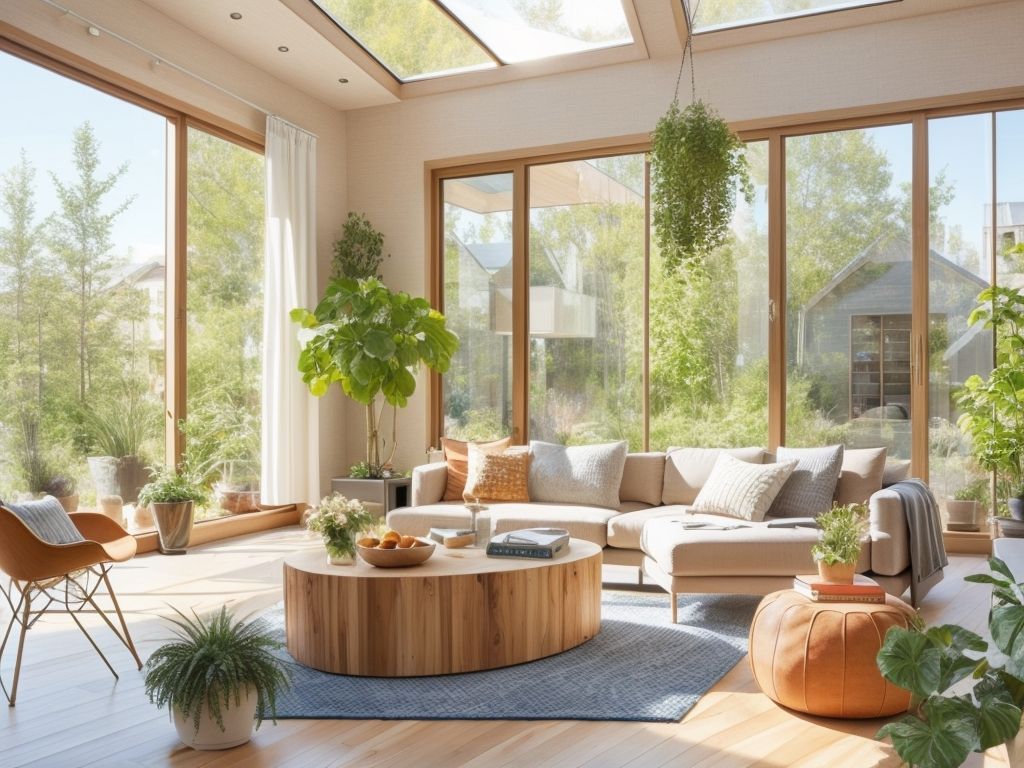Passive solar heating is a way to heat a home using the sun. To understand what would be in a passive solar home, consider these elements.
- Large south-facing windows or glazed areas allow the most sunlight in during winter. Plus, thermal mass like brick, stone, or concrete can absorb and store heat from the sun.
- Good insulation on walls and roofs helps reduce energy use. Operable shading like awnings or blinds also control sun exposure.
- Ventilation strategies support energy efficiency. Think strategically placed vents or windows for natural cooling.
Pro Tip: Get professional help for passive solar heating in your home. They’ll provide expert advice for design tailored to your location and needs.
What is passive solar heating?
Passive solar heating is a way of using the sun’s energy to warm a building without any machines or electrical gadgets. You can do this by thinking about the design, materials, and direction it faces.
Key elements of passive solar heating include:
- South-facing windows and other openings that allow sunlight in when the sun is lower in the sky, during the colder months.
- Thermal mass materials like concrete or stone inside the building to absorb and store solar heat, giving off warmth gradually.
- Well-insulated walls, floors, and roofs to keep the heat inside.
You can also add other features to your home, such as:
- Shading like overhangs or trees to block the summer sun when cooling is needed.
- Ventilation systems to help circulate air and cool down the building.
Remember, when you design a home for passive solar heating, you need to look at the climate, sunlight, and energy needs to get the best results.
Benefits of passive solar heating
Passive solar heating brings many perks for homes. Firstly, it uses the sun’s energy to warm up living spaces, reducing dependence on traditional heating systems. It helps to cut down on energy usage and lowers utility bills. Moreover, this way of heating gives consistent warmth all day without needing manual adjustments. Plus, it improves indoor air quality by cutting back on forced-air systems that spread dust and allergens. In addition, passive solar heating lessens carbon emissions and promotes sustainability by making use of renewable energy sources. And, homeowners with passive solar heating get to enjoy enhanced comfort and a cozy atmosphere in their homes.
Moreover, passive solar heating systems can be paired with other energy-saving elements like well-insulated windows and thermal mass materials to maximize its advantages. The smart positioning of windows and shading devices also plays a huge role in optimizing heat gain and retention.
The Anasazi people who lived in the south-western U.S. provide a great historic example of the benefits of passive solar heating. They fashioned their dwellings with south-facing openings to get the winter sun’s warmth during chilly desert nights. The use of adobe construction materials aided in absorbing and keeping heat throughout the day.
Passive solar heating remains an inventive solution for homeowners who desire sustainable ways to improve comfort while cutting down on energy costs. By accessing nature’s sources, this method has plenty of advantages that help individuals as well as the environment.
How does passive solar heating work?
Passive solar heating takes advantage of the sun’s free heat. South-facing windows are positioned to soak up sunlight, when the sun is lower. This sunlight enters and warms materials such as walls, furniture and flooring. This radiates warmth into the living space.
To boost this effect, thermal mass materials like concrete and brick are used inside the home. These materials store heat during the day and slowly release it at night, helping maintain a consistent temperature. Plus, insulation helps stop heat from escaping through walls, floors and roofs.
For centuries, cultures have used passive solar heating. The Anasazi people in North America designed dwellings with large south-facing windows. Ancient Greeks built their houses facing south for maximum exposure to the sun.
Materials and technologies for passive solar heating
Passive solar heating involves certain materials and tech to make the most of sunlight for heating. They work together for an eco-friendly, energy-efficient home.
- Insulation helps heat stay inside by blocking walls, floors, and roofs.
- High thermal mass materials, like concrete or adobe, absorb and store heat for later. This helps maintain a consistent temperature.
- Solar collectors capture energy and turn it into heat. Examples are solar panels and water heaters.
Strategies like south-facing windows, overhangs, and ventilation systems enhance passive solar heating.
Take advantage of these sustainable options for a greener home and future. Cut down on fossil fuels and create an energy-efficient haven. Start implementing passive solar heating techniques today!
Implementing passive solar heating in your home
Assess your home’s orientation to get the best solar gain. South-facing windows are a must for winter sunlight.
Improve insulation to keep heat in. This includes adding to walls, floors, and attics. Seal gaps and cracks to prevent cold air coming in.
Incorporate thermal mass materials like concrete or stone where the sun hits directly. They absorb heat during the day and release it at night.
Think about solar panels for the roof to generate electricity for heating and appliances.
Window treatments like blinds or curtains can control heat gain and loss. Open them to let warmth in and close them to retain heat.
Reap the rewards of passive solar heating. Financial savings, reduced reliance on fossil fuels and promotion of renewable energy sources make it a great choice. Homeowners around the world have adopted passive solar heating for its effectiveness in conserving energy while providing comfort year round. (Source: U.S Department of Energy).
Maintenance and troubleshooting
Inspect & clean solar panels regularly for max efficiency. Look for any leaks or damages in the system & repair quickly. Monitor temps & adjust as needed for comfort & energy savings. Keep an eye on ventilation, to avoid blockages & malfunctions.
Plus, professional maintenance can extend the lifespan of the passive solar heating system, reducing the need for troubleshooting. Consult with experts for specific guidelines.
Fun Fact: Passive solar heating has been used since ancient times – Greeks & Romans designed buildings to make the most of solar energy (source: National Renewable Energy Laboratory).
Conclusion
Passive solar heating in homes boosts energy efficiency and sustainability. By using natural light, thermal mass materials, and insulation, homeowners can reduce their dependence on traditional heating systems. This method saves money and helps the environment too.
Plus, passive solar homes often have large south-facing windows and overhangs. These windows maximize sunlight penetration to warm the living spaces. Thermal mass materials, such as concrete or masonry, inside walls or floors, capture and store heat during the day. This reduces the need for extra heating at night.
Proper insulation is key to stop heat loss or gain through walls, roofs, and windows. High insulation materials are often used in passive solar homes to create an airtight envelope. This reduces energy loss and increases comfort.
Take Mrs. Jenkins as an example. She lives in a cold climate and incorporated passive solar design into her home. With smartly placed windows and optimal insulation, Mrs. Jenkins saved a lot on her heating bills and enjoyed a cozy indoor temperature.
Additional resources and references
In order to gain a comprehensive understanding of passive solar heating and its practical applications in residential settings, there are various resources available. These include:
- Websites such as the U.S. Department of Energy’s, which supply comprehensive guides and articles.
- Books that offer in-depth insights, case studies, and design techniques.
- Research papers in academic journals that investigate effectiveness and impact on energy efficiency.
- Professional organizations like the American Solar Energy Society (ASES), which provide webinars, conferences, and forums.
- Local libraries with books, magazines, and periodicals related to sustainable architecture and renewable energy sources.
One should also talk to professionals who specialize in sustainable home design or consult an architect experienced in passive solar heating. To make the most of these resources, focus on reputable sources, take notes, discuss ideas, consider different perspectives, and stay informed of new developments.
Frequently Asked Questions
FAQ 1:
Q: What is passive solar heating?
A: Passive solar heating is a system that utilizes the sun’s energy to naturally heat a home without the need for mechanical systems or electricity.
FAQ 2:
Q: How does passive solar heating work?
A: Passive solar heating works by using building elements such as windows, walls, and floors to absorb, store, and distribute heat from the sun throughout the home.
FAQ 3:
Q: What would you expect to find in a home with passive solar heating?
A: In a home with passive solar heating, you would typically find large south-facing windows, thermal mass materials like concrete or stone, and well-insulated walls to maximize heat absorption and retention.
FAQ 4:
Q: Can passive solar heating be used in all climates?
A: While passive solar heating is beneficial in most climates, its effectiveness may vary. Homes in colder climates may require additional insulation and backup heating systems to ensure optimal comfort during colder seasons.
FAQ 5:
Q: What are the advantages of passive solar heating?
A: Some advantages of passive solar heating include reduced reliance on traditional heating systems, lower energy costs, decreased environmental impact, and a potentially healthier indoor environment due to improved air quality.
FAQ 6:
Q: Are there any drawbacks to passive solar heating?
A: One potential drawback of passive solar heating is the initial cost of implementing the system, as it may require specific design and construction considerations. Additionally, passive solar heating may not provide consistent results on cloudy or extremely shaded days.
Related posts:
- How Much Does Solar Increase Home Value? | Zillow Insights
- How Much Do Home Solar Panels Cost? A Complete Guide to Solar Panel Prices
- Determining the Perfect Size: How Much kW Solar Panel is Required for Your Home
- How Many Solar Panels to Power Home? A Comprehensive Guide on Calculating Solar Panel Requirements



